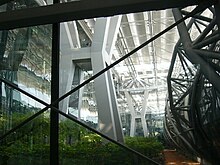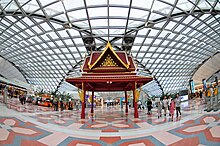The airport is located in Racha Thewa in Bang Phli district, Samut Prakan Province, about 25 kilometres (16 mi) east of downtown Bangkok. The name Suvarnabhumi was chosen by King Bhumibol Adulyadej and refers to the golden kingdom hypothesised to have been located somewhere in Southeast Asia.
Designed by Helmut Jahn of Murphy/Jahn Architects, the airport has the world's tallest control tower (132.2 metres / 434 feet), and the world's third largest single-building airport terminal (563,000 square metres / 6,060,000 square feet). Suvarnabhumi is the 3rd busiest airport in Asia, and the busiest in the country, having handled 42.7 million passengers in 2010, and is also a major air cargo hub. The airport inherited the airport code BKK from Don Mueang after the older airport ceased international commercial flights. A modern motorway no.7 connects the airport, Bangkok, and the heavily industrial Eastern Seaboard of Thailand, where most of the manufacturing for export takes place.
History
Land purchase, early construction
Planning of a second international airport for Bangkok started in the early 1960s. The process was slow from the start: as early as 1968, critics were already charging that the project was "five to seven years" behind the main schedule.The 8,000-acre (32 km2) plot of land occupied by the airport was purchased in 1973, but the student-led protests on 14 October that year led the overthrow of the military government of Prime Minister Thanom Kittikachorn and the project was shelved. After a series of ups and downs, the "New Bangkok International Airport" company (NBIA) was formed in 1996. Due to political and economic instabilities, notably the Asian financial crisis of 1997, the civil construction began six years later in January 2002 by the government of Thaksin Shinawatra. The airport is located in a once low-lying marsh, formerly known as Nong Ngu Hao (Thai: หนองงูเห่า, lit. "Cobra Swamp"), which took 5 years (1997–2001) to clear make a land reclamation. In 2005, the construction supervision and management was transferred to the Airports of Thailand PLC, while the NBIA company was dissolved.
Financing
Fifty percent of the airport's construction cost was covered by Airports of Thailand, while the another 50% was from a friendly agreement of AOT and the Japan Bank for International Cooperation (JBIC). Airport-related procurement followed JBIC's stringent guidelines for transparency and openness. Despite populism regarding the airport as being built for passengers, Thai and foreigner exporting companies in the area for a long time wanted a round the clock airport built along with a modern motorway between factories, Bangkok, and the port of Laem Chabang.Early construction, airport tests, and official opening
The airport was due to open in late 2005, but a series of budget overruns, construction flaws, and allegations of corruption plagued the project.A further problem was the belief that the airport was haunted by spirits, and sightings of ghosts by superstitious construction workers, so that on 23 September 2005, the Thai airports authority held a ceremony with 99 Buddhist monks chanting prayers to calm these spirits.
Symbolic first test flights involving two Thai Airways aircraft were held on 29 September 2005, a previously announced deadline for opening.
Full tests of the airport, with seats sold to the public, took place on 3 July and 29 July 2006. Six airlines – Thai Airways International, Nok Air, Thai Air Asia, Bangkok Airways, PBair and One-Two-GO – used the airport as a base for 20 domestic flights. The first international test flights were conducted on 1 September 2006. Two THAI's aircraft, Boeing 747-400 and Airbus A300-600, simultaneously departed the airport on 09:19 to Singapore and Hong Kong. At 15:50 the same aircraft flew back and made simultaneous touchdowns on runways 19L and 19R. These test flights demonstrated the readiness of the airport to handle heavy traffic.
On 15 September 2006, the airport started limited daily operations with Jetstar Asia Airways operating three flightsSingapore to Bangkok flight 3K511 The first commercial arrival Singapore flight 3K512 and Thai Airways International operating some domestic flights to Phitsanulok, Chiang Mai and Ubon Ratchathani. Bangkok Airways moved on 21 September, AirAsia and Thai AirAsia followed suit on 25 September and on 26 September Nok Air moved to Suvarnabhumi Airport. During this initial phase, as well as in the previous tests, the airport used the temporary IATA code NBK.
Suvarnabhumi officially opened at 03:00 on 28 September 2006, taking over all flights from Don Mueang. The first flight to arrive was Lufthansa Cargo flight LH8442 from Mumbai at 03:05. The first commercial when officially opened arrival was from Japan Airlines at 03:30. The first passenger arrival was Aerosvit flight VV171 from Kiev at 04:30, and the first cargo departure was Saudi Arabian Airlines flight SV-984 to Riyadh at 05:00. Aerosvit also had the first passenger departure (VV172 to Kiev) around 05:30.
Initial difficulties
Many difficulties were recorded in the first few days of the airport's operation. On the first day alone, sluggish luggage claims were common – the very first passenger arrival by Aerosvit took an hour for the luggage to start coming out, and some flights did not have their luggage coming out even after four hours. Also flights were delayed (Thai Airways claimed that 17 of 19 flights were delayed that day), and there were also failures with the check-in system. Subsequent problems included the failure of the cargo computer system, and the departure boards displaying the wrong information, resulting in confused passengers (especially as unlike Don Muang, there were no "final calls" issued).Months into its opening, issues such as congestion, construction quality, signage, provision of facilities, and soil subsidence continued to plague the project, prompting calls to reopen Don Mueang to allow for repairs to be done. Expert opinions varied widely regarding the extent of Suvarnabhumi's problems as well as their root cause; most airlines stated that damage to the airport was minimal. Prime Minister Surayud Chulanont decided on 16 February 2007 to reopen Don Mueang for domestic flights on a voluntary basis, with 71 weekly flights moved back initially, with no international flights allowed.
Capacity and safety issues
Problems with the tarmac
The Engineering Institute of Thailand conducted investigations at the airport in late 2006 after signs of distress were spotted at several locations in Suvarnabhumi's taxiways and taxilanes. Rutting was found in five of the six taxilanes and one of the six taxiways. Plastic deformation of the asphalt wearing course was observed near the takeoff position of the runway. However, the investigators noted that plastic deformation at this location was a common phenomenon and only routine maintenance was required to repair the distress. Aside from this surface distortion, both runways were in good structural condition.Further investigations found that that taxilane and taxiway rutting was caused by separation of the asphalt binder from the aggregate surface due to prolonged water infiltration into the asphalt concrete base course, a phenomenon known as "stripping." The 23-centimetre (9.1 in) thick base course is the top-most layer of the tarmac. Core samples indicated that the concrete base course material contained the correct job mix and aggregate gradation. Below the base course are the binder course, the wearing course, and the cement-treated base.
Detailed investigations found that water seepage was evident along the rims of the expansion joints in the cement-tested base, indicating that a large quantity of water was still trapped in the sand blanket (the bottom-most layer of the tarmac). It was found that water trapped in the sand blanket was fully confined with no connection to the pavement areas of the airport. A later investigation by the AoT identified several potential reasons for the trapped water in the sand blanket. The AoT's findings were disputed by several experts.
The Engineering Institute of Thailand sent a formal warning to the AoT in November 2006 about the urgent need to drain water from beneath the tarmac, and the need for immediate action. "The AOT did nothing about the problem," Suebsak Promboon of the EIT later noted. "The situation might not have become this bad if the water had been drained then."
In January 2007, ruts were discovered in the runways at Suvarnabhumi. The east runway was scheduled to close for repairs. Expert opinions have varied widely as to the root cause of the ruts. Airport authorities and airline representatives maintained that the airport was still safe and resisted suggestions that the airport should be completely closed and all flights moved back to Don Muang.
On 27 January 2007, however, the Department of Civil Aviation declined to renew the airport's safety certificate, which expired the previous day. The ICAO requires that international airports hold aerodrome safety certificates, but Suvarnabhumi will continue to operate because the ICAO requirement has yet to be adopted as part of Thai law.











No comments:
Post a Comment